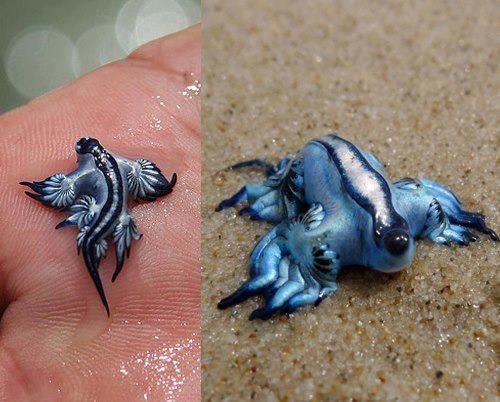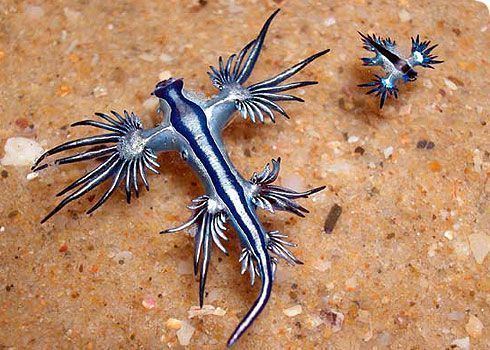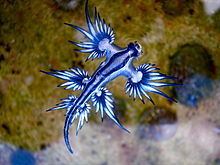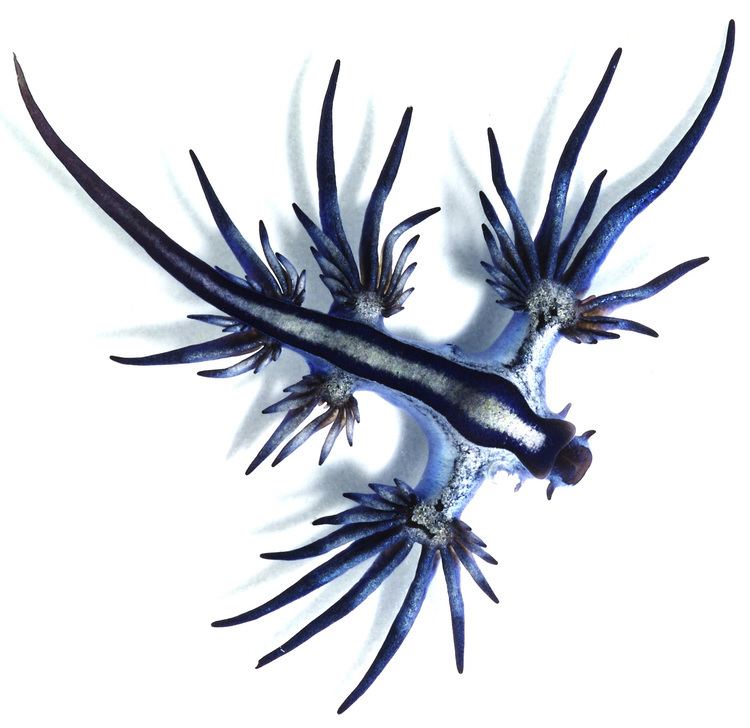Superfamily Aeolidioidea Genus Glaucus Rank Species Higher classification Glaucus | ||
 | ||
Similar Glaucus, Nudibranch, Portuguese man o' war, Molluscs, Glaucidae | ||
Blue sea slug two glaucus atlanticus and a glaucus marginatus or glaucillus marginatus
Glaucus atlanticus (common names include the sea swallow, blue angel, blue glaucus, blue dragon, blue sea slug and blue ocean slug) is a species of small, blue sea slug, a pelagic aeolid nudibranch, a shell-less gastropod mollusk in the family Glaucidae.
Contents
- Blue sea slug two glaucus atlanticus and a glaucus marginatus or glaucillus marginatus
- Glaucus atlanticus feeding
- Taxonomy
- Description
- Buoyancy and coloration
- Distribution and habitat
- Life history and behavior
- Sting
- References

These sea slugs are pelagic: they float upside down by using the surface tension of the water to stay up, where they are carried along by the winds and ocean currents. Glaucus atlanticus is camouflaged: the blue side of their body faces upwards, blending in with the blue of the water. The silver/grey side of the sea slugs faces downwards, blending in with the silvery surface of the sea.

Glaucus atlanticus feeds on other pelagic creatures, including the venomous siphonophore, the Portuguese man o' war. This sea slug stores stinging nematocysts from the cnidarian within its own tissues as defense against predation. Humans handling the slug may receive a very painful and potentially dangerous sting.

Glaucus atlanticus feeding
Taxonomy

This species looks similar to, and is closely related to, Glaucus marginatus, which is now understood to be not one species, but a cryptic species complex of four separate species that live in the Indian Ocean and Pacific Ocean.
Description

At maturity Glaucus atlanticus can be up to 3 centimetres (1.2 in) in length. It is silvery grey on its dorsal side and dark and pale blue ventrally. It has dark blue stripes on its head. It has a flat, tapering body and six appendages that branch out into rayed, finger-like cerata.
The radula of this species bears serrated teeth.
Buoyancy and coloration

With the aid of a gas-filled sac in its stomach, G. atlanticus floats at the surface. Due to the location of the gas sac, this species floats upside down. The upper surface is actually the foot (the underside in other slugs and snail), and this has either a blue or blue-white coloration. The true dorsal surface (carried downwards in G. atlanticus) is completely silver-grey. This coloration is an example of countershading, which helps protect it from predators that might attack from below and from above. The blue coloration is also thought to reflect harmful UV sunlight.
Distribution and habitat
This nudibranch is pelagic, and there is some evidence that it occurs throughout the world's oceans, in temperate and tropical waters. It has been recorded from the east and south coasts of South Africa, European waters, the east coast of Australia, and Mozambique.
Glaucus atlanticus was recently found in the Humboldt Current ecosystem in Peru in 2013, and off Andhra Pradesh in India in 2012. This is in line with the known habitat characteristics of the species: they live in warm temperate climates in the Southern Pacific, and in circumtropical and Lusitanian environments. Before finding Glaucus atlanticus off Andhra Pradesh, these nudibranchs were documented as having been seen in the Bay of Bengal and off the coast of Tamil Nadu, India, over 677 kilometers apart. Glaucus atlanticus was also recently found off Bermuda in January 2016.
Although these sea slugs live on the open ocean, they sometimes accidentally wash up onto the shore, and therefore they may be found on beaches.
Life history and behavior
G. atlanticus preys on other larger pelagic organisms. The sea slugs can move toward prey or mates by using their cerata to make slow swimming movements. They are known to prey on the dangerously venomous Portuguese man o' war Physalia physalis; the by-the-wind-sailor Velella velella; the blue button Porpita porpita; and the violet snail, Janthina janthina. Occasionally, individuals attack and eat other individuals in captivity.
G. atlanticus is able to feed on Physalia physalis due to its immunity to the venomous nematocysts. The slug consumes the entire organism and appears to select and store the most venomous nematocysts for its own use. The nematocysts are collected in specialized sacs (cnidosacs) at the tip of the animal's cerata, the thin feather-like "fingers" on its body. Because Glaucus concentrates the venom, it can produce a more powerful and deadly sting than the Man o' War on which it feeds.
Like almost all heterobranchs, Glaucus is a hermaphrodite, having both male and female reproductive organs. Unlike most nudibranchs, which mate with their right sides facing, sea swallows mate with ventral sides facing. After mating, both animals produce egg strings.
Sting
The Glaucus atlanticus is able to swallow the venomous nematocysts from siphonophores such as the Portuguese man o' war, and store them in the extremities of its finger-like cerata. Picking up the animal can result in a painful sting, with symptoms similar to those caused by the Portuguese man o' war.
